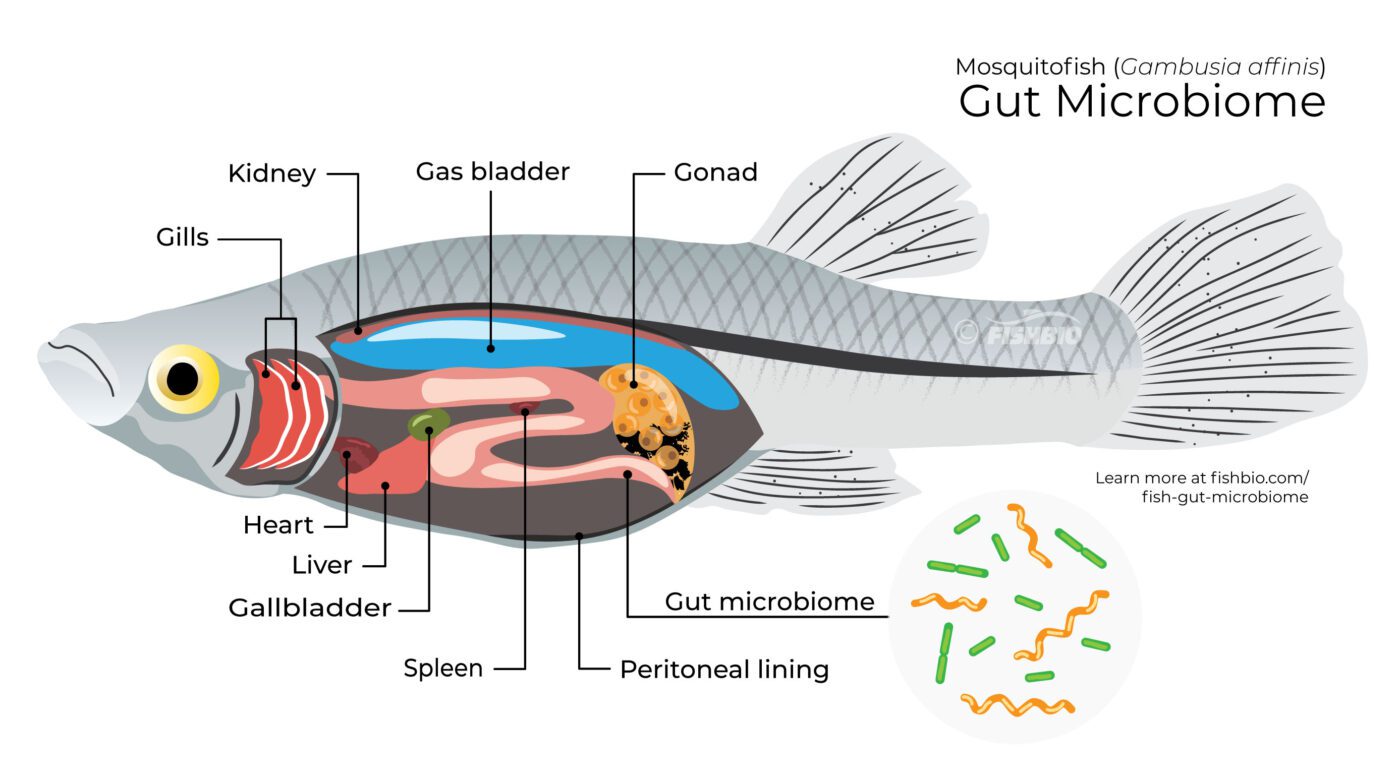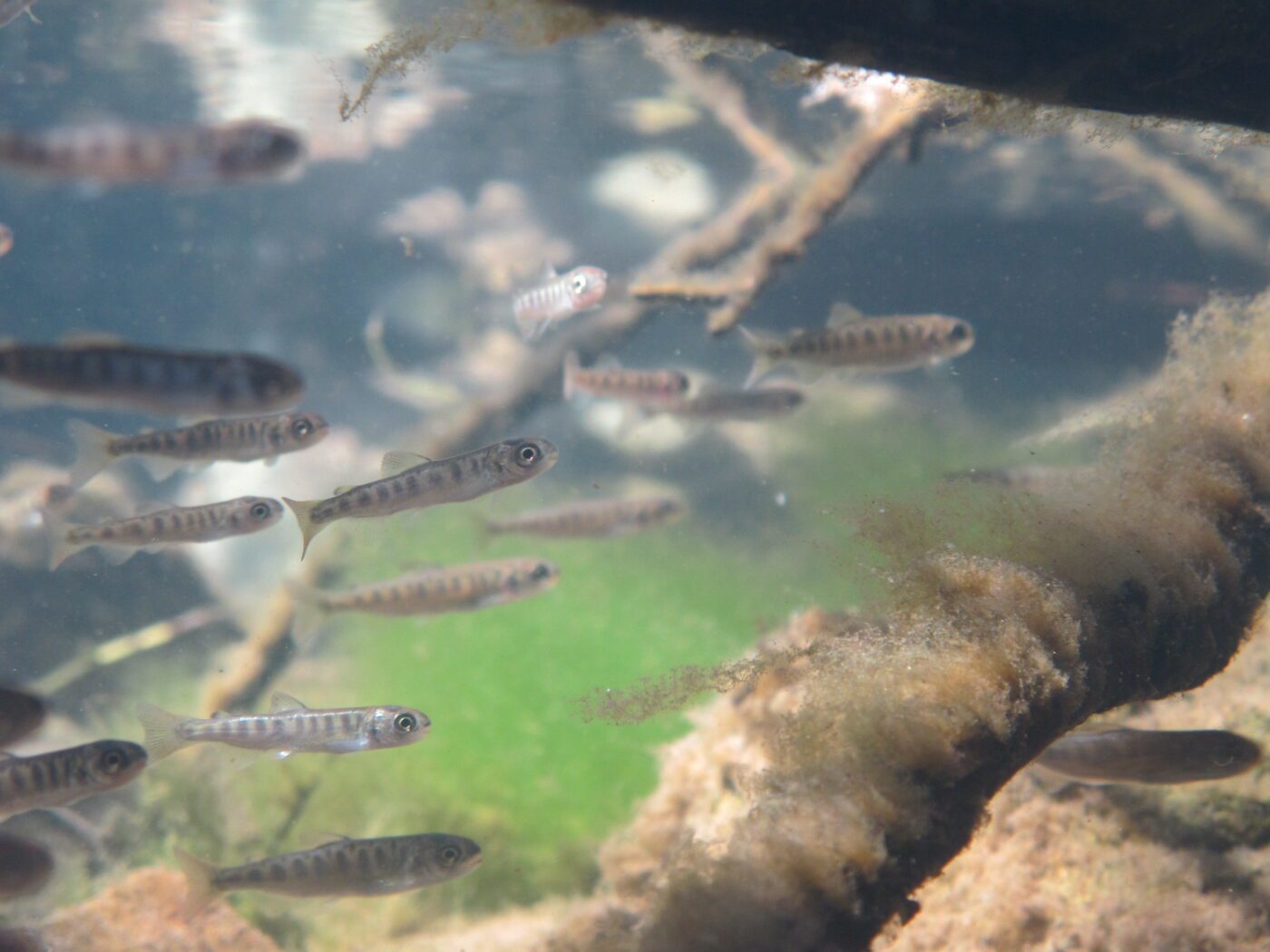Monday April 1, 2024

Humans share their bodies with trillions (that’s right, trillions!) of microorganisms, and many of them are considered essential to our health and well being. Yogurts with live cultures, natural apple cider vinegar, and probiotic supplements are popular for good reason, as a healthy microbiome is important for digestion and protection against disease. Meanwhile, a dysbiotic (or imbalanced) microbiome may make some diseases worse. Fish are no different, and they harbor these tiny organisms in their gills, mucus, and guts. Modern microbial sequencing techniques have spurred growth in microbiome research in the fields of fisheries conservation and aquaculture. The gut microbiome refers to the microbes that live inside the gastrointestinal tract of a fish. It is thought that over millennia of coevolution, hosts and microbes have developed symbiotic relationships, providing benefits to both parties.

Rearing fish in a laboratory setting allows researchers to study the transfer of microbiomes from parents to offspring, as well as the influence of diet.
The gut microbiome changes as fish develop. In most fish (those that lay eggs), the gut microbiome begins forming after the egg is laid and microbes from the environment begin to interact with and attach to the egg’s surface. At the larval stage, fish diversify their gut microbiome by ingesting water from their environment and egg debris. As juvenile fish begin to eat, their microbiome changes quickly and becomes more diverse. Finally, the gut microbiome experiences a shift, maturing along with the fish as they reach adulthood. It is thought that fish in the same species share many of the same microbes – a “core microbiome” – regardless of whether the fish are raised in the same location.
Many factors, including dietary changes and changes in the environment can influence the kinds of microbes found in the gut. To understand the role that individual species of microbes and groups of microbes play in fish health, scientists use “gnotobiotic” models. Gnotobiotic fish are fish that are germfree, or have only known or controlled microbes. Using gnotobiotic fish, researchers discovered specific microbes important for proper neurobehavioral development, protection against disease, stress and anxiety regulation, and metabolism. Thus, it stands to reason that fostering a happy, healthy, and diverse gut microbiome ultimately benefits the host, fish or human.

The microbiome of young fish like these Chinook fry is influenced by their environment.
Antibiotics are important tools to fight bacterial infections in both humans and fish, but they are linked to reduced gut microbial diversity which can alter stress responses and growth in fish. This is particularly relevant in aquaculture settings where, just as in terrestrial livestock production, antibiotics are commonly used to prevent rampant infection and subsequent production losses. Global demand for food fish is growing faster than any terrestrial protein source, with a global consumption of around 156 million metric tons of fish in 2018. It was estimated that fish produced in aquaculture settings made up 46 percent of consumed fish, spurring the aquaculture field to explore alternative methods to antibiotics (including probiotic supplementation) to promote health and reduce disease outbreaks in captive rearing settings.
In addition to aquaculture facilities, conservation hatcheries also rear fish in captivity to maintain native biodiversity and supplement populations facing extinction in the wild. Survival of these hatchery-reared fish after their release into the wild is imperative to the success of recovery programs. However, hatchery environments artificially select certain traits and gut microbes that may not be beneficial to fish survival in natural environments. Thus, understanding the function of individual species of gut microbes in fish health may allow probiotic supplementation of hatchery-reared fish to increase their ability to cope with environmental challenges upon release.

Fish reared in hatcheries may develop microbiomes that are not beneficial in the wild.
An improved understanding of fish gut microbiomes not only promises advances in fish conservation, but could even translate to human health benefits. In fact, recent research documented bacteria with antimicrobial properties living in the guts of deep-sea fish. This group of bacteria produces substances called bacteriocins during stressful periods, which are toxic to other species of bacteria (including many that cause foodborne illnesses) to reduce competition for resources. Thus, these microbes may be used for novel antimicrobial medications that target foodborne infections.

Studying the microbiomes of fish in polluted habitats like this runoff treatment pond can provide insight into the impacts that pollution can have on fish health.
While fish have evolved traits suited to their environment, human-caused changes to aquatic ecosystems (e.g., climate change, pollution, etc.) are rapidly outpacing the ability of fish to adapt to these changes. Gut microbes have been implicated in conferring protection to their hosts against some of these changes. For example, the gut microbiome provides protective effects to tadpoles in response to heat stress, which may improve their resilience against projected warming conditions associated with climate change. As such, the fish gut microbiome may be an important puzzle-piece to the future of fish conservation, aquaculture production, endangered species recovery, and even human health.
Header Image: Diagram of the internal anatomy of a mosquitofish.
This post was featured in our weekly e-newsletter, the Fish Report. You can subscribe to the Fish Report here.
